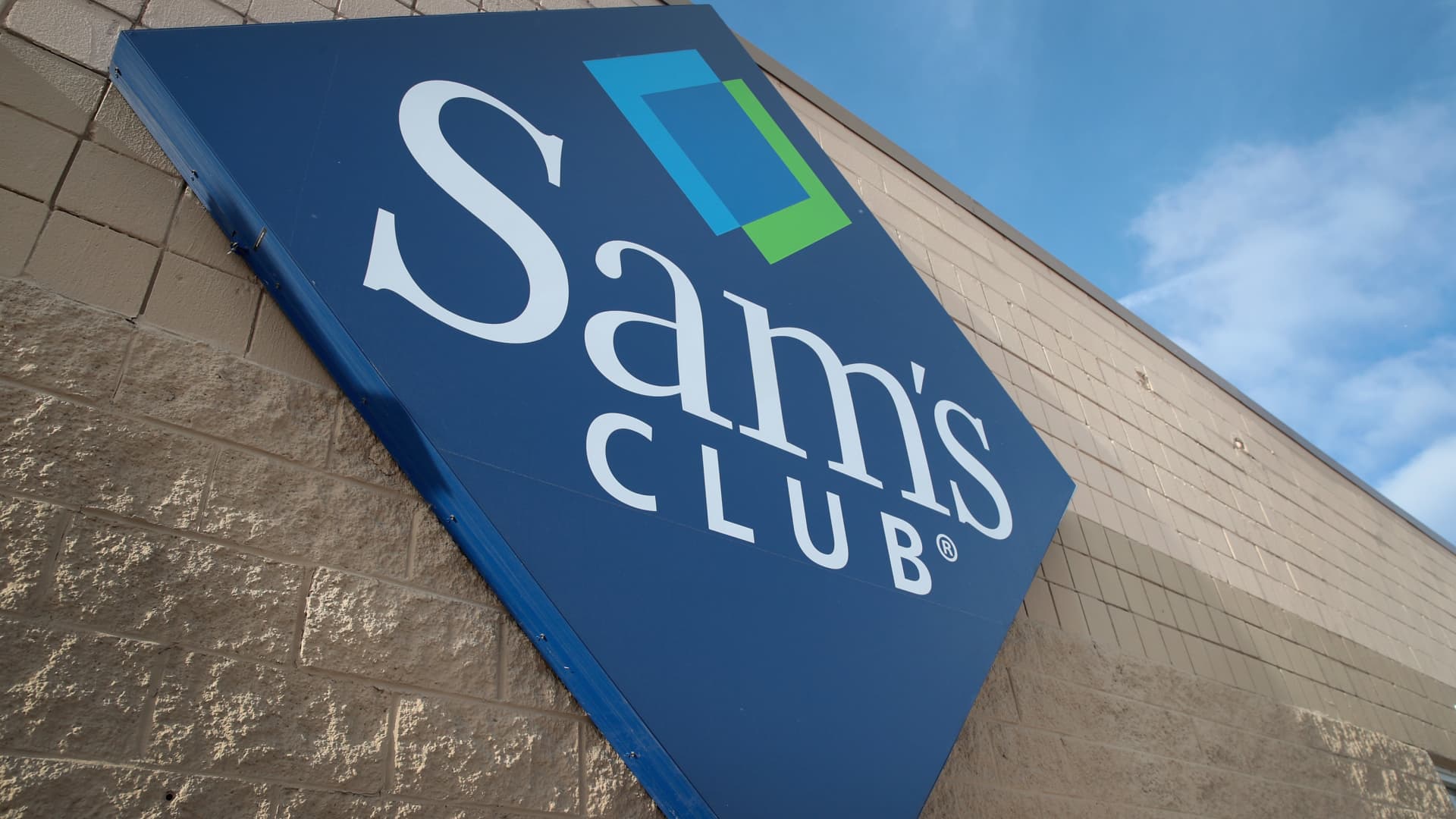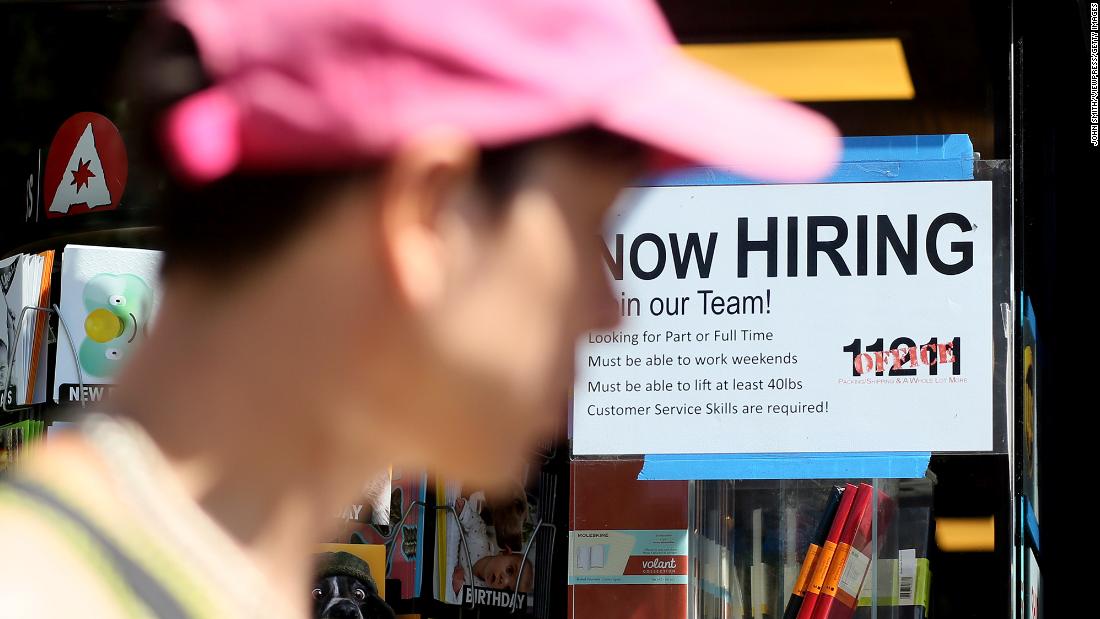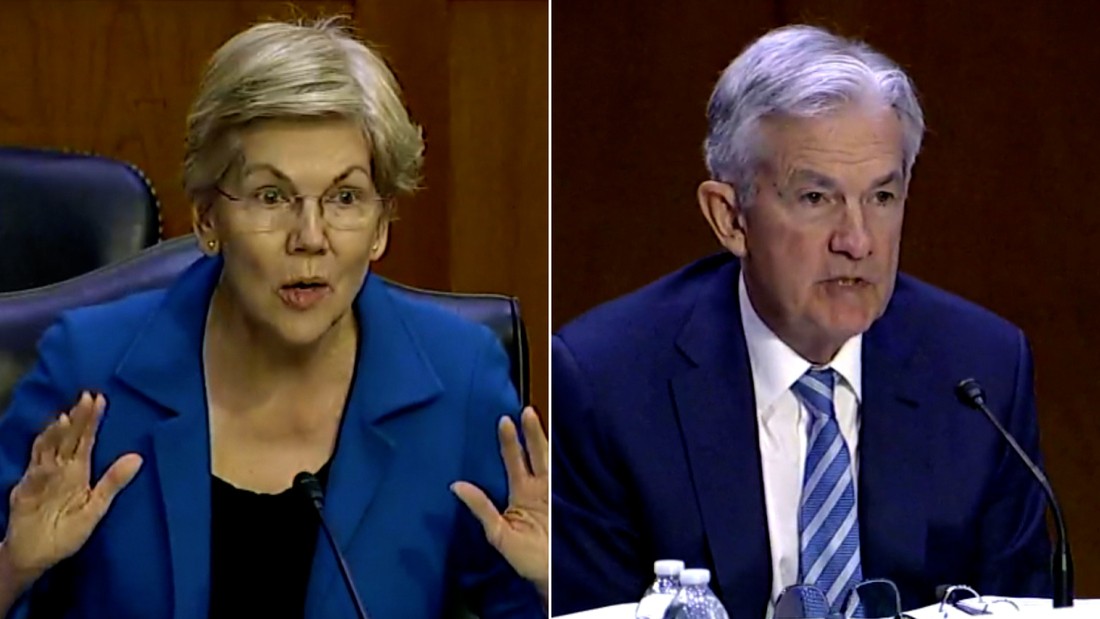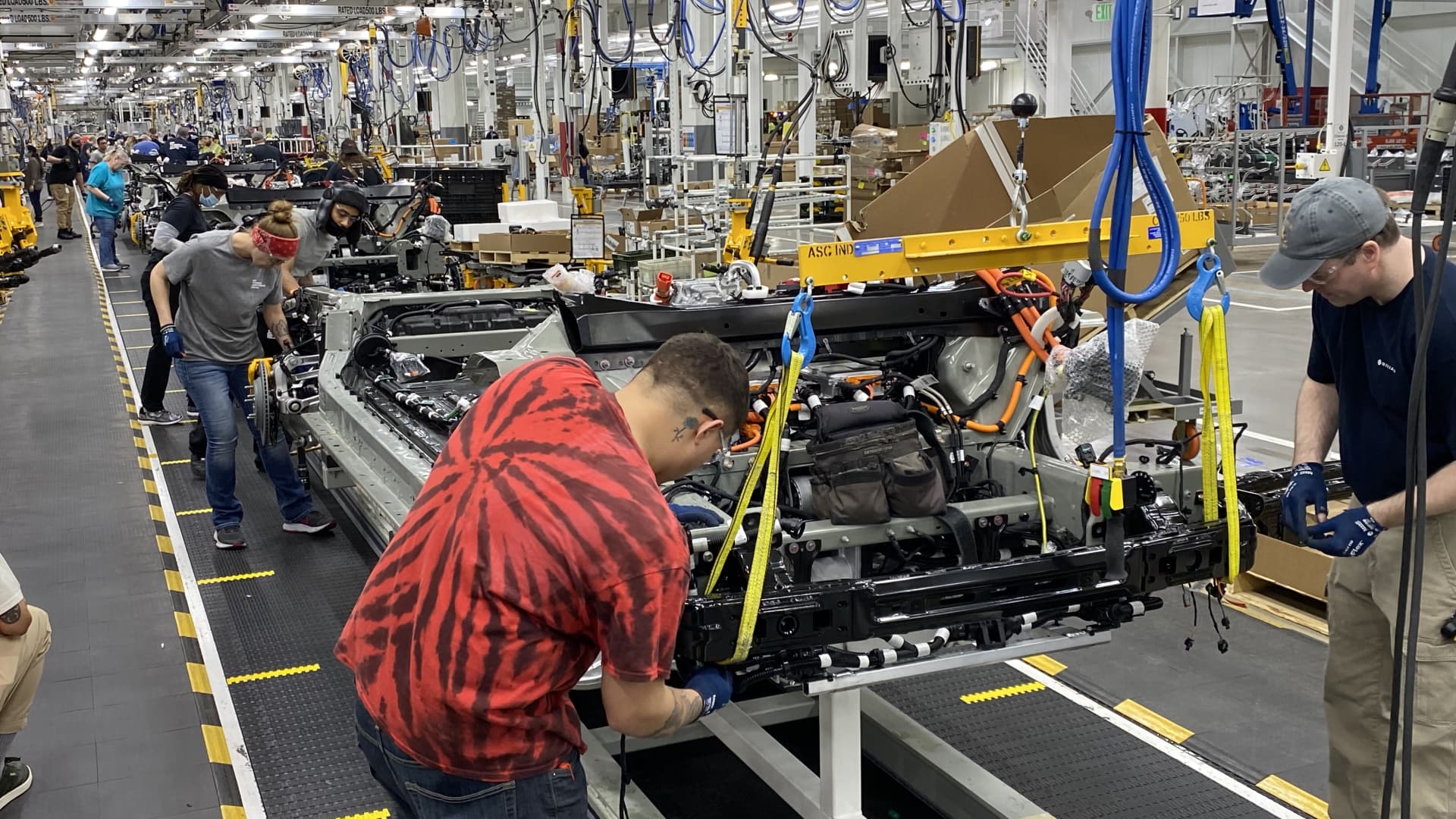Production of electric Rivian R1T pickup trucks on April 11, 2022 at the company's plant in Normal, Ill.
Michael Wayland / CNBC
In the transition from gas-powered vehicles to electric, the fuel every automaker is after these days is cold hard cash.
Established automakers and startups alike are rolling out new battery-powered models in an effort to meet growing demand. Ramping up production of a new model was already a fraught and expensive process, but rising material costs and tricky regulations for federal incentives are squeezing coffers even further.
Prices of the raw materials used in many electric-vehicle batteries — lithium, nickel and cobalt — have soared over the last two years as demand has skyrocketed, and it may be several years before miners are able to meaningfully increase supply.
Complicating the situation further, new U.S. rules governing EV buyer incentives will require automakers to source more of those materials in North America over time if they want their vehicles to qualify.
The result: new cost pressures for what was already an expensive process.
Automakers routinely spend hundreds of millions of dollars designing and installing tooling to build new high-volume vehicles — before a single new car is shipped. Nearly all global automakers now maintain hefty cash reserves of $20 billion or more. Those reserves exist to ensure that the companies can continue work on their next new models if and when a recession (or a pandemic) takes a bite out of their sales and profits for a few quarters.
All that money and time can be a risky bet: If the new model doesn't resonate with customers, or if manufacturing problems delay its introduction or compromise quality, the automaker might not make enough to cover what it spent.
For newer automakers, the financial risks to designing a new electric vehicle can be existential.
Take Tesla. When the automaker began preparations to launch its Model 3, CEO Elon Musk and his team planned a highly automated production line for the Model 3, with robots and specialized machines that reportedly cost well over a billion dollars. But some of that automation didn't work as expected, and Tesla moved some final-assembly tasks to a tent outside its factory.
Tesla learned a lot of expensive lessons in the process. Musk said later called the experience of launching the Model 3 "production hell" and said it nearly brought Tesla to the brink of bankruptcy.
As newer EV startups ramp up production, more investors are learning that taking a car from design to production is capital-intensive. And in the current environment, where deflated stock prices and rising interest rates have made it harder to raise money than it was just a year or two ago, EV startups' cash balances are getting close attention from Wall Street.
Here's where some of the most prominent American EV startups of the last few years stand when it comes to cash on hand:
Rivian
Production of electric Rivian R1T pickup trucks on April 11, 2022 at the company's plant in Normal, Ill.
Michael Wayland / CNBC
Rivian is by far the best-positioned of the new EV startups, with over $15 billion on hand as of the end of June. That should be enough to fund the company's operations and expansion through the planned launch of its smaller "R2" vehicle platform in 2025, CFO Claire McDonough said during the company's earnings call on Aug. 11.
Rivian has struggled to ramp up production of its R1-series pickup and SUV amid supply chain snags and early manufacturing challenges. The company burned about $1.5 billion in the second quarter, but it also said it plans to reduce its near-term capital expenditures to about $2 billion this year from $2.5 billion in its earlier plan to ensure it can meet its longer-term goals.
At least one analyst thinks Rivian will need to raise cash well before 2025: In a note following Rivian's earnings report, Morgan Stanley analyst Adam Jonas said that his bank's model assumes Rivian will raise $3 billion via a secondary stock offering before the end of next year and another $3 billion via additional raises in 2024 and 2025.
Jonas currently has an "overweight" rating on Rivian's stock, with a $60 price target. Rivian ended trading Friday at roughly $32 per share.
Lucid
People test drive Dream Edition P and Dream Edition R electric vehicles at the Lucid Motors plant in Casa Grande, Arizona, September 28, 2021.
Caitlin O'Hara | Reuters
Luxury EV maker Lucid Group doesn't have quite as much cash in reserve as Rivian, but it's not badly positioned. It ended the second quarter with $4.6 billion in cash, down from $5.4 billion at the end of March. That's enough to last "well into 2023," CFO Sherry House said earlier this month.
Like Rivian, Lucid has struggled to ramp up production since launching its Air luxury sedan last fall. It's planning big capital expenditures to expand its Arizona factory and build a second plant in Saudi Arabia. But unlike Rivian, Lucid has a deep-pocketed patron — Saudi Arabia's public wealth fund, which owns about 61% of the California-based EV maker and would almost certainly step in to help if the company runs short of cash.
For the most part, Wall Street analysts were unconcerned about Lucid's second-quarter cash burn. Bank of America's John Murphy wrote that Lucid still has "runway into 2023, especially considering the company's recently secured revolver [$1 billion credit line] and incremental funding from various entities in Saudi Arabia earlier this year."
Murphy has a "buy" rating on Lucid's stock and a price target of $30. He's compared the startup's potential future profitability to that of luxury sports-car maker Ferrari. Lucid currently trades for about $16 per share.
Fisker
People gather and take pictures after the Fisker Ocean all-electric SUV was revealed at Manhattan Beach Pier on November 16, 2021 in Manhattan Beach, California.
Mario Tama | Getty Images
Unlike Rivian and Lucid, Fisker isn't planning to build its own factory to construct its electric vehicles. Instead, the company founded by former Aston Martin designer Henrik Fisker will use contract manufacturers — global auto-industry supplier Magna International and Taiwan's Foxconn — to build its cars.
That represents something of a cash tradeoff: Fisker won't have to spend nearly as much money up front to get its upcoming Ocean SUV into production, but it will almost certainly give up some profit to pay the manufacturers later on.
Production of the Ocean is scheduled to begin in November at an Austrian factory owned by Magna. Fisker will have considerable expenses in the interim — money for prototypes and final engineering, as well as payments to Magna — but with $852 million on hand at the end of June, it should have no trouble covering those costs.
RBC analyst Joseph Spak said following Fisker's second-quarter report that the company will likely need more cash, despite its contract-manufacturing model — what he estimated to be about $1.25 billion over "the coming years."
Spak has an "outperform" rating on Fisker's stock and a price target of $13. The stock closed Friday at $9 per share.
Nikola
Nikola Motor Company
Source: Nikola Motor Company
Nikola was one of the first EV makers to go public via a merger with a special-purpose acquisition company, or SPAC. The company has begun shipping its battery-electric Tre semitruck in small numbers, and plans to ramp up production and add a long-range hydrogen fuel-cell version of the Tre in 2023.
But as of right now, it probably doesn't have the cash to get there. The company has had a tougher time raising funds, following allegations from a short-seller, a stock price plunge and the ouster of its outspoken founder Trevor Milton, who is now facing federal fraud charges for statements made to investors.
Nikola had $529 million on hand as of the end of June, plus another $312 million available via an equity line from Tumim Stone Capital. That's enough, CFO Kim Brady said during Nikola's second-quarter earnings call, to fund operations for another 12 months — but more money will be needed before long.
"Given our target of keeping 12 months of liquidity on hand at the end of each quarter, we will continue to seek the right opportunities to replenish our liquidity on an ongoing basis while trying to minimize dilution to our shareholders," Brady said. "We are carefully considering how we can potentially spend less without compromising our critical programs and reduce cash requirements for 2023."
Deutsche Bank analyst Emmanuel Rosner estimates Nikola will need to raise between $550 million and $650 million before the end of the year, and more later on. He has a "hold" rating on Nikola with a price target of $8. The stock trades for $6 as of Friday's close.
Lordstown
Lordstown Motors gave rides in prototypes of its upcoming electric Endurance pickup truck on June 21, 2021 as part of its "Lordstown Week" event.
Michael Wayland / CNBC
Lordstown Motors is in perhaps the most precarious position of the lot, with just $236 million on hand as of the end of June.
Like Nikola, Lordstown saw its stock price collapse after its founder was forced out following a short-seller's allegations of fraud. The company shifted away from a factory model to a contract-manufacturing arrangement like Fisker's, and it completed a deal in May to sell its Ohio factory, a former General Motors plant, to Foxconn for a total of about $258 million.
Foxconn plans to use the factory to manufacture EVs for other companies, including Lordstown's Endurance pickup and an upcoming small Fisker EV called the Pear.
Despite the considerable challenges ahead for Lordstown, Deutsche Bank's Rosner still has a "hold" rating on the stock. But he's not sanguine. He thinks the company will need to raise $50 million to $75 million to fund operations through the end of this year, despite its decision to limit the first production batch of the Endurance to just 500 units.
"More importantly, to complete the production of this first batch, management will have to raise more substantial capital in 2023," Rosner wrote after Lordstown's second-quarter earnings report. And given the company's difficulties to date, that won't be easy.
"Lordstown would have to demonstrate considerable traction and positive reception for the Endurance with its initial customers in order to raise capital," he wrote.
Rosner rates Lordstown's stock a "hold" with a price target of $2. The stock closed Friday at $2.06.
Adblock test (Why?)
Cash is king for EV makers as soaring battery prices drive up vehicle production costs - CNBC
Read More

















